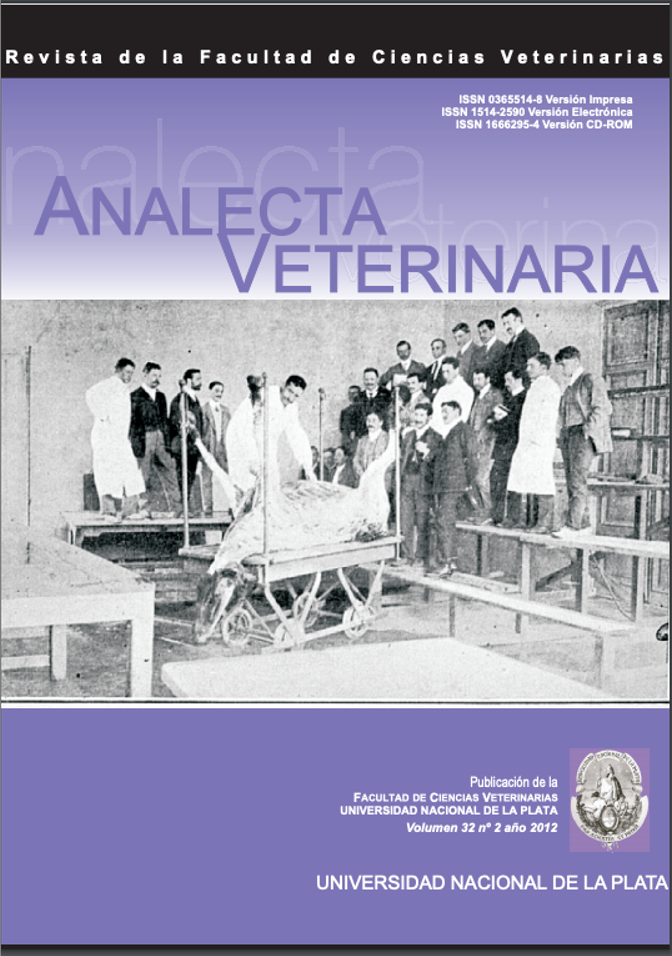Penetración de fosfomicina en explantes intestinales
Keywords:
Fosfomicina, Deoxinivalenol, Explantes intestinales, CerdosAbstract
Fosfomycin (FOS) is an antibiotic used in pig farms for treatment and prevention of infections caused by resistant bacteria during post-weaning period. Antibiotics and non-toxic concentrations of such mycotoxins as deoxynivalenol (DON) are frequently found in the diet of animals. These compounds can establish interactions in the intestinal tract which affect and/or modify the penetration of FOS to enterocytes. The aim of this study was to culture intestinal explants from jejuna of pigs and to apply this model to the study of intracellular penetration of FOS in presence or absence of DON. The use of intestinal explants reduces the number of animals sacrificed per experiment and preserves normal intestinal histological structure in vitro. The results showed that there was no statistically significant difference in the intracellular concentration of FOS between explants incubated with 580 ppm FOS and explants incubated with 580 ppm FOS and 1 ppm DON. The Cmax was 12 ppm and the tmax was 2 h. Our study proved that only the 2% of the antibiotic is intracellularly accumulated and that the intracellular concentration of FOS is not affected by the presence of non-toxic concentrations of DON.
Downloads
Metrics
References
Mata J, Rodriguez A, Gallego A. Fosfomycin: in vitro activity. Chemotherapy 1977; 23 (suppl l): 23–24.
Kahan FM, Kahan JS, Cassidy PJ, Kropp H. The mechanism of action of fosfomycin (phosphonomycin). Ann NY Acad Sc 1974; 235: 364–386.
Popovic M, Steinort D, Pillai S, Joukhadar C. Fosfomycin: an old, new friend? Eur J Clin Microbiol Infect Dis 2010; 29 (2): 127–142.
Gobernado M. Fosfomicina. Rev Esp Quimioter 2003; 16 (1): 15-40.
Gallego A, Rodriguez A, Mata JM. Fosfomycin: pharmacological studies. Drugs Today 1974; 10:161–168.
Aramayona JJ, Bregante MA, Solans C, Rueda S, Fraile LJ, Garcia MA. Pharmacokinetics of fosfomycin in chickens after a single intravenous dose and tissue levels following chronic oral administration. Vet Res 1997; 28 (6): 581–588.
Carraminana JJ, Rota C, Agustin I, Herrera A. High prevalence of multiple resistance to antibiotics in Salmonellae serovars isolated from a poultry slaughterhouse in Spain. Vet Microbiol 2004; 104: 133-139.
Borsa F, Leroy A, Fillastre JP, Godin M, Moulin B. Comparative pharmacokinetics of tromethamine fosfomycin and calcium fosfomycin in young and elderly adults. Antimicrob Agents Chemother 1988; 32: 938-941.
Patel SS, Balfour JA, Bryson HM. Fosfomycin tromethamine. A review of its antibacterial activity, pharmacokinetic properties and therapeutic efficacy as a single-dose oral treatment for acute uncomplicated lower urinary tract infections. Drugs, 1997; 53: 637-656.
Soraci AL, Perez DS, Martinez G, Dieguez S, Tapia MO, Amanto F, Harkes R, Romano O. Disodium-fosfomycin pharmacokinetics and bioavailability in post weaning piglets. Res Vet Sci 2011; 90: 498-502.
Pakhomova S, Bartlett S, Augustus A, Kuzuyama T, Newcomer M. Crystal structure of fosfomycin resistance kinase FomA from Streptomyces wedmorensis. J Biol Chem. 2008; 283(42): 28518-26.
Dirkzwager A, Veldman B, Bikker P. A nutritional approach for the prevention of post weaning syndrome in piglets. Anim Res 2005; 54: 231-236.
Soraci AL, Amanto F, Hartes R, Pérez D, Martínez G, Diéguez SN, Tapia MO. Uso estratégico de aditivos: impacto sobre el equilibrio y salud gastrointestinal del lechón. Analecta Vet 2010; 30 (1): 42-53.
Nabuurs MJA. Weaning piglets as a model for studying pathophysiology of diarrhea. Vet quart 1998; 20 (3): 42-45.
Lawlor P, Brendan Lynch P. Mycotoxins in pig feeds 2: clinical aspects. Ir Vet J 2001; 54 (4): 172-176.
Pestka JJ. Deoxynivalenol: toxicity, mechanisms and animal health risks. Anim Feed Sci Technol 2007;137: 283–298.
Rotter BA, Thompson BK, Lessard M, Trenholm HL, Tryphonas H. Influence of low-level exposure to Fusarium mycotoxins on selected inmunological and hematological parameters in young swine. Fund Appl Toxicol 1994; 23: 117-124.
Nietfeld JC, Tyler DE, Lenn RH, Cole JR, Latimer KS, Wayne AC. Culture and morphologic features of small intestinal mucosal explants from weaned pigs. A J Vet Res 1991; 52 (7): 1142-1146.
Kolf-Clauw M, Castellote J, Joly B, Bourges-Abella N, Raymond-Letron I, Pinton P, Oswald I. Development of a pig jejunal explant culture for studying the gastrointestinal toxicity of the mycotoxin deoxynivalenol: Histopathological analysis. Toxicol in Vitro 2009; 23:1580–1584.
Zhu Ch, Harel J, Jacques M, Fairbrother JM. Interaction with pig ileal explants of Escherichia coli 045 isolates from swine with postweaning diarrhea. Can J Vet Res 1995; 59: 118-123.
Ruckebusch Y. Physiologie Pharmacologie Therapeutique animals. 2nd. Ed. Maloine S.A., 1981.
Isengard HD. Rapid water determination in foodstuffs. Trends in Food Science & Technology 1995; 6 (5): 155–162.
Danielsen EM, Sjöström H, Norén O, Bro B, Dabelsteent E. Biosynthesis of intestinal microvillar proteins. Biochem J 1982; 202: 647-654.
German AJ, Hall EJ, Day MJ. Relative deficiency in IgA production by duodenal explants from German shepherd dogs with small intestinal disease. Vet Immunol Immunopathol 2000; 76: 25–43.
Höger PH, Seger RA, Schaad UB, Hitzig WH. Chronic granulomatous disease: uptake and intracellular activity of fosfomycin in granulocytes. Pediatr Res 1985; 19 (1): 38-44.
Goyarts T, Dänicke S. Bioavailability of the Fusarium toxin deoxynivalenol (DON) from naturally contaminated wheat for the pig. Toxicol Lett 2006;163 (3): 171–182.
Awad WA, Aschenbach JR, Setyabudi FMCS, Razzazi-Fazeli E, Böhm J, Zentek J. In vitro effects of Deoxynivalenol on small intestinal D -glucose uptake and absorption of Deoxynivalenol across the isolated jejunal epithelium of laying hens. Poult Sci 2007; 86:15–20.
Maresca M, Mahfoud R, Garmy N, Fantini J. The mycotoxin deoxynivalenol affects nutrient absorption in human intestinal epithelial cells. J Nutr 2002; 132: 2723–2731.
Downloads
Published
How to Cite
Issue
Section
License
Authors retain the copyright and assign to the journal the right of the first publication, with the with the terms of the Creative Commons attribution license. This type of license allows other people to download the work and share it, as long as credit is granted for the authorship, but does not allow them to be changed in any way or used them commercially.

Analecta Veterinaria by School of Veterinary Sciences, National University of La Plata is distributed under a Creative Commons Attribution-NonCommercial-NoDeriv 4.0 International License.

























